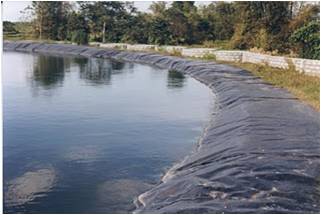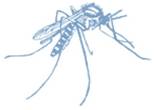Difference between revisions of "Practitioner's Tool / Sewage Lagoons"
m (Winona moved page Sewage Lagoons to Practitioner's Tool / Technology and Operation / Sewage Lagoons without leaving a redirect) |
|
(No difference)
| |
Revision as of 20:28, 28 September 2016
Sewage lagoons are lined ponds or basins that treat wastewater through the physical action of settling and the biological action of microbial digestion. Also known as waste stabilization ponds, sewage lagoons are popular because they are relatively inexpensive and easy to design, install and maintain and can produce a good quality effluent. They do, however, require large land areas.
Contents
Basic Design of Sewage Lagoon Systems
There are several components of a sewage lagoons system:
- Headworks, which typically consist of bar screens, flow metering and distribution piping before influent reaches lagoon cells
- Lined basins usually constructed in parallel to allow for routine desludging of individual cells
- Outlet structures that include flow discharge weirs, level control piping and filters for removing algae
- Disinfection devices, which are installed as the last step
Pros and Cons of Lagoon Systems
While cost and available land may be the overriding factors when considering wastewater treatment technology options, planners should consider the following when evaluating lagoon systems:
| Advantages | Disadvantages / Limitations |
|
|
Operation and Safety of Sewage Lagoons
Nuisances at lagoons may include odor, mosquitoes, weeds in the water and on the banks, and algae accumulations. Nuisances can be controlled by following best management practices to deal with challenges for sewage lagoons:
- Mosquitoes. Establish a monitoring program and control mosquito breeding with biological or chemical methods. Monitor mosquitoes weekly and use appropriate controls based on the life stage of the mosquito observed (larvicide for larvae, for example).
- Equipment maintenance. Keep equipment clean and in good working order.
- Algae. Remove accumulated algae and dispose of it as solid waste, compost it or reuse it as animal feed.
- Vegetation. Cut grass and brush next to the lagoon, but do not let the clippings fall into the water because they provide breeding sites for mosquitoes. Small animals such as goats or sheep may also be used to control vegetation.
- Solid waste. Place screenings, weeds, trash and other debris in covered containers and dispose of waste in a landfill.
Sewage Lagoon Safety
There are many accidents that can occur at sewage lagoons, including drowning, electrocution, and contact with pathogens. Because of the hazards, all lagoon systems should be fenced or have controlled access with appropriate signs to keep unauthorized people out.
Berms and dikes should be inspected weekly or monthly to identify areas of leakage and weakness. A break can result in flooding of downstream areas and serious negative health consequences. All sewage lagoon systems should have an operation and maintenance plan that describes routine operational tasks, troubleshooting procedures for controlling nuisances, and health and safety procedures for workers.


